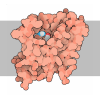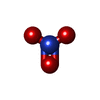+ Open data
Open data
- Basic information
Basic information
| Entry | Database: PDB / ID: 7xa9 | ||||||
|---|---|---|---|---|---|---|---|
| Title | Structure of Arabidopsis thaliana CLCa | ||||||
 Components Components | Chloride channel protein CLC-a | ||||||
 Keywords Keywords |  MEMBRANE PROTEIN / MEMBRANE PROTEIN /  nitrate / nitrate /  antiporter / antiporter /  transport protein transport protein | ||||||
| Function / homology |  Function and homology information Function and homology informationnitrate transmembrane transport / nitrate transmembrane transporter activity / response to nitrate / voltage-gated chloride channel activity / chloride transport /  chloride channel complex chloride channel complexSimilarity search - Function | ||||||
| Biological species |   Arabidopsis thaliana (thale cress) Arabidopsis thaliana (thale cress) | ||||||
| Method |  ELECTRON MICROSCOPY / ELECTRON MICROSCOPY /  single particle reconstruction / single particle reconstruction /  cryo EM / Resolution: 2.84 Å cryo EM / Resolution: 2.84 Å | ||||||
 Authors Authors | Ji, S. / Jin, H. / Kaiming, Z. / Mingxing, W. / Shanshan, L. / Long, C. | ||||||
| Funding support |  China, 1items China, 1items
| ||||||
 Citation Citation |  Journal: J Biol Chem / Year: 2023 Journal: J Biol Chem / Year: 2023Title: Cryo-EM structure of the plant nitrate transporter AtCLCa reveals characteristics of the anion-binding site and the ATP-binding pocket. Authors: Jin He / Mingxing Wang / Shanshan Li / Long Chen / Kaiming Zhang / Ji She /  Abstract: Nitrate is one of the major nitrogen sources for most plants. Chloride channel (CLC) proteins mediate the transport and vacuole storage of nitrate in plants, but the structural basis of nitrate ...Nitrate is one of the major nitrogen sources for most plants. Chloride channel (CLC) proteins mediate the transport and vacuole storage of nitrate in plants, but the structural basis of nitrate transport by plant CLC proteins remains unknown. Here, we solved the cryo-EM structure of ATP-bound Arabidopsis thaliana CLCa (AtCLCa) at 2.8 Å resolution. Structural comparison between nitrate-selective AtCLCa and chloride-selective CLC-7 reveals key differences in the central anion-binding site. We observed that the central nitrate is shifted by ∼1.4 Å from chloride, which is likely caused by a weaker interaction between the anion and Pro160; the side chains of aromatic residues around the central binding site are rearranged to accommodate the larger nitrate. Additionally, we identified the ATP-binding pocket of AtCLCa to be located between the cytosolic cystathionine β-synthase domains and the N-terminus. The N-terminus may mediate the ATP inhibition of AtCLCa by interacting with both ATP and the pore-forming transmembrane helix. Together, our studies provide insights into the nitrate selectivity and ATP regulation of plant CLCs. | ||||||
| History |
|
- Structure visualization
Structure visualization
| Structure viewer | Molecule:  Molmil Molmil Jmol/JSmol Jmol/JSmol |
|---|
- Downloads & links
Downloads & links
- Download
Download
| PDBx/mmCIF format |  7xa9.cif.gz 7xa9.cif.gz | 242.5 KB | Display |  PDBx/mmCIF format PDBx/mmCIF format |
|---|---|---|---|---|
| PDB format |  pdb7xa9.ent.gz pdb7xa9.ent.gz | 199.1 KB | Display |  PDB format PDB format |
| PDBx/mmJSON format |  7xa9.json.gz 7xa9.json.gz | Tree view |  PDBx/mmJSON format PDBx/mmJSON format | |
| Others |  Other downloads Other downloads |
-Validation report
| Arichive directory |  https://data.pdbj.org/pub/pdb/validation_reports/xa/7xa9 https://data.pdbj.org/pub/pdb/validation_reports/xa/7xa9 ftp://data.pdbj.org/pub/pdb/validation_reports/xa/7xa9 ftp://data.pdbj.org/pub/pdb/validation_reports/xa/7xa9 | HTTPS FTP |
|---|
-Related structure data
| Related structure data |  33088MC M: map data used to model this data C: citing same article ( |
|---|---|
| Similar structure data | Similarity search - Function & homology  F&H Search F&H Search |
- Links
Links
- Assembly
Assembly
| Deposited unit | 
|
|---|---|
| 1 |
|
- Components
Components
| #1: Protein |  / AtCLC-a / CBS domain-containing protein CBSCLC5 / AtCLC-a / CBS domain-containing protein CBSCLC5Mass: 88176.820 Da / Num. of mol.: 2 Source method: isolated from a genetically manipulated source Source: (gene. exp.)   Arabidopsis thaliana (thale cress) / Gene: CLC-A, CBSCLC5, At5g40890, MHK7.12 / Production host: Arabidopsis thaliana (thale cress) / Gene: CLC-A, CBSCLC5, At5g40890, MHK7.12 / Production host:   Homo sapiens (human) / References: UniProt: P92941 Homo sapiens (human) / References: UniProt: P92941#2: Chemical | ChemComp-NO3 /  Nitrate Nitrate#3: Chemical |  Adenosine triphosphate Adenosine triphosphate#4: Chemical | Has ligand of interest | Y | |
|---|
-Experimental details
-Experiment
| Experiment | Method:  ELECTRON MICROSCOPY ELECTRON MICROSCOPY |
|---|---|
| EM experiment | Aggregation state: PARTICLE / 3D reconstruction method:  single particle reconstruction single particle reconstruction |
- Sample preparation
Sample preparation
| Component | Name: AtCLCa / Type: COMPLEX / Entity ID: #1 / Source: RECOMBINANT |
|---|---|
| Source (natural) | Organism:   Arabidopsis thaliana (thale cress) Arabidopsis thaliana (thale cress) |
| Source (recombinant) | Organism:   Homo sapiens (human) / Cell: HEK293F Homo sapiens (human) / Cell: HEK293F |
| Buffer solution | pH: 8 |
| Specimen | Embedding applied: NO / Shadowing applied: NO / Staining applied : NO / Vitrification applied : NO / Vitrification applied : YES : YES |
Vitrification | Cryogen name: ETHANE |
- Electron microscopy imaging
Electron microscopy imaging
| Microscopy | Model: FEI TITAN |
|---|---|
| Electron gun | Electron source : :  FIELD EMISSION GUN / Accelerating voltage: 300 kV / Illumination mode: FLOOD BEAM FIELD EMISSION GUN / Accelerating voltage: 300 kV / Illumination mode: FLOOD BEAM |
| Electron lens | Mode: BRIGHT FIELD Bright-field microscopy / Nominal defocus max: 3000 nm / Nominal defocus min: 1500 nm Bright-field microscopy / Nominal defocus max: 3000 nm / Nominal defocus min: 1500 nm |
| Image recording | Electron dose: 60 e/Å2 / Film or detector model: GATAN K3 (6k x 4k) |
- Processing
Processing
| Software | Name: PHENIX / Version: 1.17.1_3660: / Classification: refinement | ||||||||||||||||||||||||
|---|---|---|---|---|---|---|---|---|---|---|---|---|---|---|---|---|---|---|---|---|---|---|---|---|---|
CTF correction | Type: NONE | ||||||||||||||||||||||||
3D reconstruction | Resolution: 2.84 Å / Resolution method: FSC 0.143 CUT-OFF / Num. of particles: 2913673 / Symmetry type: POINT | ||||||||||||||||||||||||
| Refine LS restraints |
|
 Movie
Movie Controller
Controller



 PDBj
PDBj






